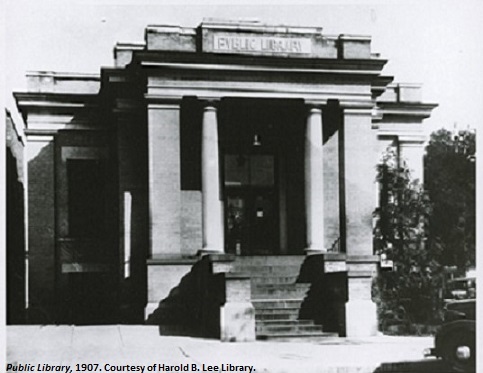Dublin Core
Title
Description
Public libraries are a staple of many of Utah’s communities. Learn how public libraries got started in Utah.
October is National Book Month and libraries all over Utah are celebrating with book festivals and activities to help bring readers and writers together. Many of us depend on our local libraries for more than books, but have you ever wondered how public libraries came about in our state?
In the late 19th century, public libraries in Utah were operated by individuals and private groups such as churches and service clubs. By the turn of the century, however, most had realized that enthusiasm and idealism were not enough to keep the doors open, and that a steady source of funding was needed. Library funding became accepted as a legitimate function of local government in 1896 when the Utah Legislature created the legal basis for tax-supported libraries and gave cities the authority to raise taxes for libraries in 1907.
Private groups continued to organize public libraries, but began to cooperate with city government. In 1903, for example, a book club in Provo started a library with books furnished from donations, but turned to the city for its space and management needs. In Kanab, the Ladies Literary League raised money and books from dances, book showers, and operettas, before giving the city responsibility for the library. Utah communities from Richmond to St. George received funds to build libraries from industrialist Andrew Carnegie, on the condition that the cities provide funding for maintenance and books. By 1920 there were 43 tax-supported libraries in Utah.
The first State Secretary for Libraries, Howard Driggs, envisioned libraries as the center of community culture and education, which would serve as an alternative to saloons, and create a home for what he called “street boys." Thanks in part to Driggs’ energetic advocacy, the period from 1900 to 1930 saw an unprecedented expansion in the number of public libraries across the state. It’s a legacy we still enjoy today.
Creator
Source
Image: Public Library. Provo's first library of major consequence. Located at First East and Center, it was completed in 1907 through a Carnegie grant of $17,500. It was enlarged and modernized in 1939. Courtesy of Harold B. Lee Library.
_______________
See Max J. Evans and Miriam B. Murphy, “The Beginning of Public Support for Libraries,” History Blazer, July 1996, accessed http://historytogo.utah.gov/utah_chapters/statehood_and_the_progressive_era/thebeginningofpublicsupportforlibraries.html; Max J. Evans, "A History of the Public Library Movement in Utah" (M.S. thesis, Utah State University, 1971).

